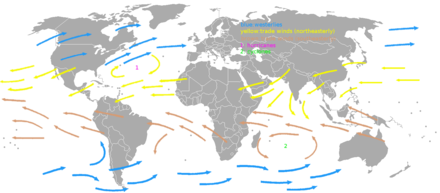West wind zone

The westerly wind zone , westerly wind position or westerly wind drift describes an atmospheric air circulation in the middle latitudes of the earth, i.e. between about 40 ° and 60 ° in the northern and southern hemisphere. Sometimes the current can reach up to 70 ° latitude . It runs in the direction of rotation of the earth from west to east and is part of the planetary circulation .
In contrast to other global wind currents such as the trade fair circulation , winds from western directions prevail in the westerly wind zone both on the ground and at the height of the troposphere , but the wind conditions are comparatively uneven. These air masses are thermally moderate and relatively humid.
Creation of the west wind zone
These westerly winds arise from the air pressure gradient between the subtropical high pressure belt and the subpolar low pressure trough and the meridional air mass exchange resulting from it . The east rotating earth has its greatest circumference parallel to the latitude ( equator ) in the tropics . The air masses moving in the tropics and subtropics therefore have a larger total volume. The earth's surface and above it in calm air masses have a very high speed in an easterly direction due to the earth's circumference. When air masses flow towards the poles from here, the inertia of the air masses and the Coriolis force lead to a deflection towards the east. This turns the air masses into westerly winds, which flow around the entire earth both in the northern hemisphere and in the southern hemisphere as a westerly wind zone.
Causes of Inconsistency
The instability of the west wind drift is due to the superposition of the polar front , which arises between warmer, subtropical air masses and cold polar air and forms Rossby waves . The resulting cyclogenesis and relocation of the low pressure areas in the area of the west wind drift also lead to disturbances. Further variations result from the seasonal differences in irradiation , so that the west wind drift is less pronounced in summer than in winter. Above the polar front, in the area of the west wind zone, there is a narrow strong wind field, the jet stream .
Special features in the southern hemisphere
The westerly wind drift is even more pronounced in the southern hemisphere than in the northern hemisphere, because the even colder temperatures in the Antarctic lead to a higher pressure gradient between the polar low-pressure trough and the subtropical high, but also because there are fewer landmasses in the southern hemisphere that slow down the winds, and because less often blocking high pressure areas arise. In the southern hemisphere, the westerly winds drive the circumpolar current . It is this most powerful oceanic current that is meant by west wind drift in English . Wind and water currents are the reason why sailing ships can circumnavigate the earth here faster and easier in a west-east direction than in the opposite direction. For example, the tall ships coming from Europe, Australia and New Zealand, mostly approached the route around the southern tip of South Africa, around the Cape of Good Hope , whereas the return around the southern tip of South America was around Cape Horn , although the sail around Cape Horn was due the Furious Fifties was and is extremely dangerous.
Significance for air traffic
The westerly wind zone also has a significant impact on air traffic . Flights from east to west take longer than the other way around. Airlines take the jet stream into account when planning routes in order to use it or avoid it.
Significance for the climate
As the westerly winds cross the oceans , they bring a lot of humidity with them, which they gradually lose as they cross the continents due to incline rain and cyclonic rain . The westerly winds transport the low-pressure cyclones located in the moderate latitudes eastwards. On the west coasts and in the western parts of the continents there is a maritime climate due to the wind-related influence of the sea . In the central and more eastern parts of the continents there is a continental climate with significantly lower precipitation and higher seasonal temperature differences. In those areas of the earth that are only temporarily in the area of influence of the west wind zone due to the seasonal shift of the subtropical high pressure belt, there is the winter rainy climate on the western sides, also known as the Mediterranean climate .
See also
Individual evidence
- ^ Wilhelm Lauer : Climatology. Westermann 1995. ISBN 3-14-160284-0 . Page 159–162
- ^ Wilhelm Lauer : Climatology. Westermann 1995. page 159